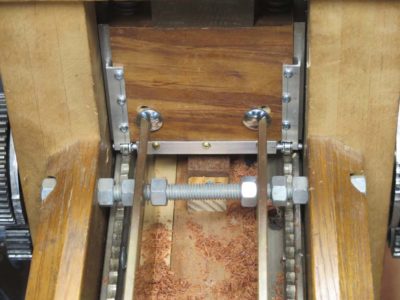Meanwhile In The Next Room: Tuning Up The Ripple Molding Machine

While I was occupied with the Roubo bench slab in the center hall of the barn John was a dozen feet away in the classroom tinkering with the Winterthur ripple molding cutter. When we gathered earlier as a group we identified a number of modifications that might serve to transform it into a reliable, precision machine. I ordered all the materials and supplies we thought we needed for this undertaking so everything was ready to go for John to dive in to making these modifications a reality.
As a moment of review, the ripple molding machine is simply a contoured scraper being drawn across a length of wood, with either the scraper or the workpiece being undulated by some sort of linear pattern. In short, a ripple molding is the result of controlled chatter.
In the case of this machine it is the cutter that remains fixed relative to the length of the frame, but which undulates up-and-down via a horizontal “follower” rod affixed to the cutterhead frame, pressing down on the pattern running the length of the machine frame. We found in our earlier efforts that either the pattern or the follower ere being degraded and even destroyed by the very process of creating the moldings.

I do not know how this problem was dealt with historically, but for our applications we decided to replace the extant follower rod with a new rod and tiny roller bearings to instead ride along the pattern, transferring the up-and-down impulse without friction to the cutterhead. John spent extensive time retrofitting the cutterhead to accommodate this modification without damaging or changing irrevocably the machine as it was presented to me.
After installing the new follower system John reported to me with a grand smile that it as a perfect solution to the problem, and would guide our design considerations as we move forward with new machines in both our futures.


Join the Conversation!